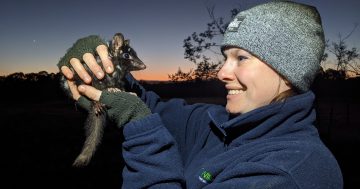
Dragonflies: Are they back? Photo: File.
Every Saturday, Morgan is in the backyard for hours at a time, cleaning the swimming pool. It gives him an excellent vantage point on Canberra’s fauna, and that meant he recently noticed something he hasn’t seen for some time – a dragonfly, skimming the water.
Region‘s social media guru isn’t on his own.
Dr Yun (Living) Li helps look after the Australian National Insect Collection (ANIC), Australia’s largest collection of insects, and other minibeasts like mites, spiders, and centipedes – more than 12 million all up – based at CSIRO.
Since 2019, he’s been photographing insects out in the wild around Canberra, and says he’s bumped into “a lot more” of them in the past three years.
“Just like your colleagues, I have recently noticed a surge in the number of dragonflies around,” he says.
“This is in stark contrast to the 2019-2020 bushfire year, when long drought and extreme weather spelled a silent ‘summer’ for these little critters.”
It’s a different story to what we’ve heard over the past 20 years. According to The Conversation, a 2020 compilation of 166 studies estimated that insect populations were “on average declining globally at a rate of 0.9 per cent per year”.
“Some studies were based on sightings by amateur entomologists, while others involved scientists counting the number of bugs splattered on car windshields,” an article from 2023 reads.
“Some collected flying insects in traps annually for years and weighed them.”
And in 2022, researchers from the James Cook University in Queensland warned of an “insect apocalypse”, with “radical effects on the environment”.

The Australian National Insect Collection is managed by CSIRO. Photo: CSIRO.
Their study found habitat loss, chemical pollution, invasive species and other human-caused changes to the environment were the main drivers, “with climate change amplifying the effects of the other threatening factors”.
“The loss of insects works its way up the food chain, and may already be playing an important role in the widespread decline of their consumers, such as insect-eating birds in temperate environments,” co-author Professor William Laurance said.
Canberra naturalist Ian Fraser told Region “sadly all the evidence is that insect numbers are declining still”.
“Climate change has a lot to do with it, but there’s a lot more to it than just temperature rises. Habitat loss is ongoing and without doubt, ever-increasing pesticide use is a contributor too, but there’s still far too much we don’t know.”
Dr Li says simply noticing more insects can be misleading too.
“Many flying insects emerge at a certain time of the year, and there is seasonality in their numbers.”
For instance, favourable weather could spur a boom of dragonfly food – insects like mosquitos – which in turn increases the abundance of dragonflies.
“In a warm and wet spring, you are likely to see dragonflies more frequently,” Dr Li says.
He adds that it’s not really known yet what any change to climate could bring for insects, except that it won’t be all doom and gloom.
“Some lowland species may benefit from warmer temperatures. By contrast, alpine species that have narrow thermal limits could be driven into extinction by global warming.
“A favourable weather condition for one species may be a doom for the other. Additionally, species with higher genetic diversity may better adapt to changing environments than species that has low genetic diversity.”

Remember when the front of cars used to look like this. Photo: James Coleman.
That said, Dr Li says the “claim that there is a rise of flying insects in the Canberra region appears to be true” – it’s just that “we do not have sufficient data to support or reject it”.
“This points to a need for long-term studies of population dynamics across a diverse range of insect groups,” he concludes.
“We can use sophisticated sampling methods to collect flying insects (like malaise trapping or light trapping). We can use cutting-edge technology to speed up specimen sorting and inventory, such as DNA meta-barcoding, AI, and robotics.
“But it takes time and efforts until we have a complete picture on the rise or decline of insects on this continent.”















